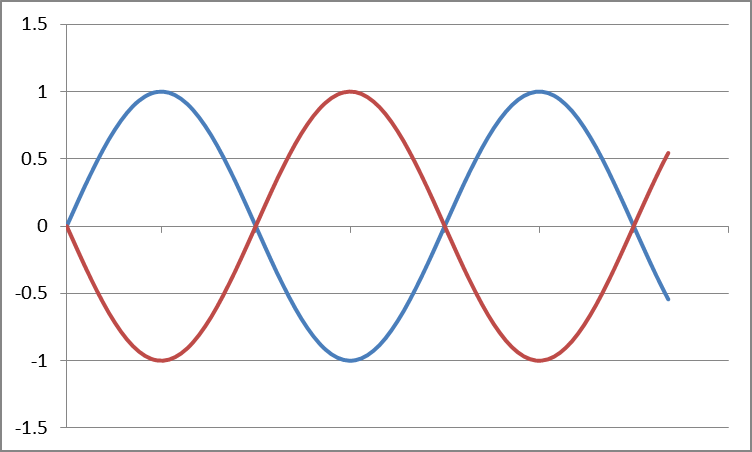https://producelikeapro.com/blog/sound-synthesis-basics/Phase cancellation is an acoustic phenomenon in which two or more “out of phase” sound waves result in weakened or lost frequencies. When two identical frequencies are cycling 180° opposite each other, complete phase cancellation occurs.
The Science Behind Phase Cancellation
Sound waves cycle at a specific rate per second designated by the wave’s frequency, which we also refer to as “hertz.” Hertz are specifically defined as one cycle per second, and a complete cycle consists of a peak and a subsequent trough equal in amplitude. When we say that a frequency is 500 Hz, for example, we’re literally referring to a sound wave completing 500 cycles per second.
Two of the same frequencies starting their cycles at the exact same time (“in phase”) are perceived as an increase in amplitude. This concept is referred to as constructive interference.
On the other hand, if the same frequencies are traveling at different or opposite rates, they are out of phase. At 180° difference–in which one cycle is at its peak and the other is at its trough–destructive interference known as phase cancellation occurs. The perceived sound is loss of the out-of-phase frequencies.
READ ALSO: Vital Synth Review
READ ALSO: Best Dynamic Microphones
READ ALSO: Cockos Reaper DAW Review
Phase cancellation can be an issue during both the tracking and mixing processes. Despite this, being familiar with it means measures can be taken to avoid frequency loss due to out-of-phase signals.
Nip It at the Source
Phase becomes a concern when multiple microphones are used on a single sound source. If the mics are not in the exact same space, one will receive the sound slightly later than the other, causing the signal to be out of phase. Repositioning the microphones to eliminate phase issues is generally the best bet. However, in certain circumstances, a polarity reversal switch on a channel strip or preamp can be engaged to flip the signal’s cycle, bringing it back in phase.
To ultimately avoid phase problems on a multi-miked single instrument, you’ll have to be sure the microphones’ capsules are as physically close together as possible. For spaced mics, placing them equidistant from the source will ensure that the direct sound is captured without time delay.
It’s also worth noting that mics should be placed at least a few feet away from walls. There is potential for the mic to pick up reflections off the walls which are not in phase with the direct sound entering the transducer.
The 3:1 Rule
If you intend to distant mike a sound source with multiple microphones, applying the 3:1 rule can reduce unwanted phase cancellation and interference. The rule states that for every unit of distance a microphone is from a sound source, the next nearest mic must be at least 3 times that distance away.
So, if the first microphone is 1 foot away from the sound source, the second should be placed a minimum of 3 feet away from the first mic with the capsules on the same plane.
Picture miking a choir. Inexperienced engineers tend to want to place as many mics as possible in front of the ensemble, all in close proximity. You can probably imagine that the phase and interference issues would be a nightmare. Ok, perhaps not a “nightmare,” but the choir would sound thin from all the phase cancellation.
If you place five microphones 6 feet away from a choir, and each mic is 3 feet from the other, you’re forgoing the 3:1 rule. Chances are, it won’t sound pretty. Instead, fewer mics, spaced appropriately, will yield better, in-phase results.
Let’s complete the choir image utilizing the 3:1 rule, with simple numbers picked for ease of understanding. Use a 3-mic setup, and place the first in the center of the group, 3 feet away. Measure 9 feet from either side of the center microphone and place the others there, making sure the capsules are all aligned. Voila! We’ve managed a multi-miked ensemble, while being conscious of the 3:1 rule for the best, most accurate representation of the sound source.
Read Also: The ‘Zoom’ for Musicians
Read Also: Portable Audio Interface
read Also: Best FREE VU Meter Plugins
Comb Filtering
A comb filter is a frequency response with consecutive, steep notches resembling the teeth of a comb. Comb filtering is a result of reflected sounds being added back to a direct sound. The time delay between the direct and reflected sounds means that specific frequencies are attenuated (out of phase) and others are reinforced (in phase).
Phase cancellation is what causes particular frequencies to be attenuated in comb filtering. As the out-of-phase reflected signal combines with the in-phase direct signal, frequencies are lost. Comb filtering and phase cancellation is a concern in untreated acoustic environments. Depending on the severity of comb filtering in an acoustic space, the tonal characteristics of a mix can be drastically altered by phase cancellation and reinforcement.
